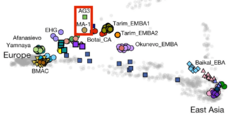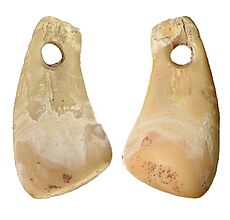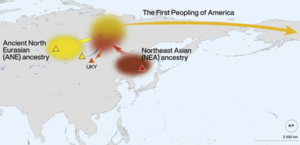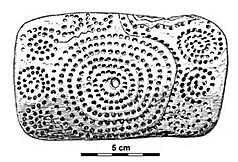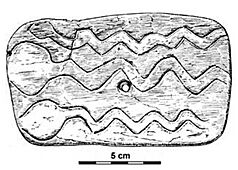Ancient North Eurasian facts for kids
|
Mal'ta–Buret' culture ivory figurines (c. 24,000 BP-c. 15,000 BP). Some of the figurines wear hooded overalls with decorative stripes.
Approximate location of the Ancient North Eurasians c. 24,000~16,000 BP.
|
The Ancient North Eurasians (ANE) were a group of ancient people who lived in Siberia a very long time ago. Scientists use their DNA to understand how different groups of people are related. The ANE are linked to the Mal'ta–Buret' culture from about 24,000 years ago and other groups like those from Afontova Gora in Siberia.
Scientists also found that the ANE are related to even older people from the Yana Rhinoceros Horn Site (about 32,000 years ago). These older people are sometimes called Ancient North Siberians. The ANE were a Siberian group who arrived from the "northern route". They were related to early European hunter-gatherers. But they also had a good amount of their ancestry (about one-third) from an "East Eurasian" group, who came to Siberia from a "southern route".
Around 20,000 to 25,000 years ago, some Ancient North Eurasian people mixed with Ancient East Asians. This mixing led to the groups that became the Ancestral Native Americans, Ancient Beringians, and Ancient Paleo-Siberians. We don't know exactly where this mixing happened. There are different ideas about how these groups met.
ANE ancestry has spread across Eurasia and the Americas through many migrations since the Upper Paleolithic (Old Stone Age). Today, more than half of the world's population has between 5% and 42% of their DNA from the Ancient North Eurasians. You can find a lot of ANE ancestry in Native Americans. It is also found in parts of northern Europe, South Asia, Central Asia, and Siberia. Some people think that their ancient stories might have been similar to myths found in both Indo-European and some Native American cultures. For example, they might have believed in a special "world tree" or a story about a dog guarding the path to the afterlife.
Genetic Discoveries
Who Were the ANE?
The ANE group is known from the DNA of the "Mal'ta boy" (MA-1). This individual lived about 24,000 years ago in central Siberia. His remains were found in the 1920s. Along with samples from the Yana Rhinoceros Horn Site and Afontova Gora, these groups are sometimes called 'Ancient North Siberians'. However, 'Ancient North Eurasian' is also used for both the Mal'ta boy and the Yana remains.

The Ancient North Eurasians were a group from Paleolithic Siberia. They were more closely related to European hunter-gatherers than to people from East and Southeast Asia. Scientists think that most of the ANE ancestry found in people today came from a group linked to Afontova Gora (AG2/3), rather than Mal'ta (MA1) or Yana.
The male Y-chromosome haplogroups linked to Ancient North Eurasians are P-M45, and its branches R and Q. Haplogroup P is thought to have started about 44,000 years ago in Southeast Asia. It came from Haplogroup K2b, which was found in the Tianyuan man from Northern China. Their female haplogroups belonged to branches of haplogroup U.
How the ANE Formed
The ANE/ANS gene pool probably formed very early during the Upper Paleolithic. This happened when an 'Ancient West Eurasian' group, traveling through Central Asia into Siberia, mixed with an 'Ancient East Eurasian' group. The West Eurasian group was related to early European people, like those from Goyet Caves and Kostenki-14. This group likely came from the Iranian Plateau. The 'East Eurasian' group is linked to the 40,000-year-old Tianyuan man from Northern China.
Overall, Ancient North Eurasians are best described as a mix: about 71% from an Ancient West Eurasian group and about 29% from an East Eurasian group. Some researchers suggest that the ANE were "Early Upper Paleolithic tribes of hunters" connected to similar groups in Southern Siberia and Central Asia. These groups were among the first modern humans to move into Siberia. This means that early people could have moved into Northeast Asia from both the west and the south.
Studies on ANE Remains
DNA samples from the Yana Rhinoceros Horn Site (31,600 years ago) in Northeastern Siberia, and the related remains from the Mal'ta–Buret' culture (MA1) and Afontova Gora (AG2/3), show they got their ancestry from an Ancient West Eurasian group. They also had a lot of DNA (22–50%) from an East Eurasian group.
Scientists have different ideas about the exact percentages of this mix. Some studies suggest the Mal'ta sample was about 82% West Eurasian and 18% East Asian. Other studies suggest the Yana and Mal'ta samples were about 68% from a group related to European hunter-gatherers (like Kostenki-14) and 32% from a group like the Tianyuan man. More recent studies suggest the Yana and Afontova Gora remains were about 73% West Eurasian and 27% East Eurasian.
The Yana people are closely related to the Mal'ta and Afontova Gora people, but they are not exactly the same. Some research suggests that the ANE (Mal'ta and Afontova Gora) are not direct descendants of the Yana population. Instead, they might be like sister groups that shared a common ancestor.
A different individual, known as the Salkhit individual (about 34,000 years ago) from Northern Mongolia, also shows a complex relationship with the Yana people. This suggests that there was mixing between Ancient West and East Eurasian groups in Northeastern Siberia.
Where ANE Lived and Spread
By about 32,000 years ago, groups with ANE-related ancestry were likely spread widely across northeast Eurasia. They might have even reached Alaska and the Yukon. But they had to leave these cold northern areas when the climate got much harsher during the Last Glacial Maximum.
Groups genetically similar to the Mal'ta boy (MA-1) and Afontova Gora contributed a lot of their genes to Native Americans, Europeans, Ancient Central Asians, South Asians, and some East Asian groups.
A study in 2016 found that the highest amount of ANE ancestry today is found in the Kets, Mansi, Native Americans, and Selkups.
The ancient Bronze Age steppe cultures like the Yamnaya and Afanasevo had a lot of ANE-like DNA (about 25–50%). This came from their Eastern Hunter-Gatherer (EHG) and Caucasus hunter-gatherer (CHG) ancestry. For Native Americans, between 14% and 38% of their ancestry might come from the Mal'ta–Buret' (ANE) population. This percentage varies because later "Neo-Siberian" migrations also entered the Americas. For example, Inuit and Alaskan Natives have lower percentages of ANE ancestry because they arrived later. Early Native Americans in the Andes region of South America show higher percentages, around 41%. The rest of Native American ancestry came from an East Asian-related group.
DNA studies also show that ANE ancestry came to Western Europe much later, with people related to the Yamnaya culture. Today, Europeans have about 10%–20% ANE ancestry. Earlier ANE ancestry is found in European hunter-gatherer groups because of mixing with Eastern European Hunter-Gatherers during the Paleolithic period. This led to groups like the Scandinavian Hunter-Gatherers.
A deer tooth pendant with the DNA of an ANE woman was found in the Denisova Cave. It is about 24,700 years old. This woman was closely related to the Mal'ta and Afontova Gora individuals found further east.
An early Neolithic (New Stone Age) Central Asian individual from Tajikistan (Tutkaul1) was mostly from Ancient North Eurasians. This person was closely related to Afontova Gora 3 (AG3) and Mal’ta 1.
Groups with ANE Ancestry
Native American Connection
Scientists believe that the Ancient North Eurasian people mixed with a group of ancient East Asians about 25,000 years ago. This mixing led to the groups that became the ancestors of Native Americans. However, we don't know the exact place where this mixing happened, and there are different ideas about how these two groups met. Some studies suggest Native Americans have mostly East Asian ancestry, with a smaller part from ancient West Eurasian groups.
One idea is that Ancient North Eurasians moved south into East Asia or Southern Siberia. There, they would have met and mixed with ancient East Asians. Genetic evidence from Lake Baikal in Mongolia supports this area as a possible mixing place.
Another idea, called the "Beringian standstill hypothesis," suggests that East Asians moved north to Northeastern Siberia. There, they mixed with ANE people. Later, these mixed groups stayed in a region called Beringia for a long time, where distinct Native American groups formed. This idea is supported by maternal and nuclear DNA evidence. However, this idea is not fully supported by paternal DNA evidence. This might mean that male and female family lines had different histories, which is common in human populations.
The groups that came from the mixing of ANE and ancient East Asians include the Ancient Beringians and Ancestral Native Americans. These are specific ancient genetic groups. For example, the DNA of an infant found in Alaska (USR1), dated to 11,500 years ago, shows this mix. The Ancient Beringian and Ancestral Native American groups formed about 25,000 years ago. Then they split, with the Ancient Beringians staying in the Beringian region, while the Ancestral Native Americans moved into the Americas. The ANE genetic contribution to early Native Americans (like the USR1 and Clovis individuals) is estimated at about 36.8%. There were also the Ancient Paleo-Siberians near Lake Baikal (about 14,000 years ago). They had about 30% ANE ancestry and 70% East Asian ancestry.
Jomon People
The Jōmon people, who lived in Japan before the New Stone Age, mostly got their ancestry from East Asian groups. But they also received some genes from the ANE-related "Ancient North Siberians" (from the Yana Rhinoceros Horn Site). This happened before they moved from the Asian mainland to Japan. Jōmon ancestry is still found in people in Japan today, especially among the Ainu people, who are thought to be direct descendants of the Jōmon. A small but important amount is also found in most of the Japanese population.
Siberian and Asian Holocene Groups
"Altai hunter-gatherer" is a name for Middle Holocene (around 10,000 years ago to today) Siberian hunter-gatherers in the Altai-Sayan region of Southern Siberia. They came from a mix of Paleo-Siberian and Ancient North Eurasian groups and are closely related to Native Americans. Bronze Age groups from North and Inner Asia with a lot of ANE ancestry (like Lake Baikal hunter-gatherers) can be linked to these Altai hunter-gatherers as an ANE-derived source.
"West Siberian Hunter-Gatherer" (WSHG) is another specific ancient genetic group. It can be described as about 20% Eastern Hunter-Gatherer (EHG), 73% ANE, and 6% Ancient Northeast Asian. Even though only a few individuals from about 5,000 BCE have been sampled, high levels of WSHG-like ancestry are found in many Central Asian populations until the Bronze Age.
Among the Ancient Northeast Asians (ANA) from the Neolithic to Early Bronze Age, groups near Lake Baikal had about 6.4% to 20.1% ancestry from ANE. The rest of their ancestry came from ANA.
Tarim Mummies
A 2021 DNA study of the Tarim mummies found that they were mostly descended from a group represented by the Afontova Gora 3 (AG3) individual. This means their genes were very similar to AG3. The AG3 genetic profile made up about 72% of the Tarim mummies' ancestry. The other 28% came from a group like the Baikal EBA (Early Bronze Age Northeast Asian Baikal populations).
The Tarim mummies are special because they are one of the few Holocene (current geological epoch) groups that got most of their ancestry from the Ancient North Eurasians (ANE, specifically the Mal'ta and Afontova Gora groups). This is true even though they lived about 14,000 years later. They seem to have kept their ANE ancestry in a kind of "genetic bottleneck" in the Tarim basin. Because of this, the Tarim mummies are considered the "best representatives" of the Ancient North Eurasians among ancient populations.
North Han Chinese Populations
Some studies show a small amount of West Eurasian-derived ancestry (2–5%) among Shaanxi Han Chinese, especially those in Guanzhong and Shaanbei. Ancient North Eurasian ancestry is more common in Shaanxi Han Chinese compared to other Han subgroups.
European Populations
Scientists found ANE ancestry in modern European populations, up to 20%. In ancient European groups, ANE genes are seen in the Yamnaya people. However, they were not found in Western or Central Europeans before the Corded Ware culture. ANE ancestry entered the European gene pool through the Eastern Hunter-Gatherer (EHG) group, which got a lot of its ancestry (about 70%) from the ANE. The rest came from a group related to, but different from, Western Hunter-Gatherers (WHGs).
After the Last Glacial Maximum ended, the Western Hunter-Gatherers (WHG) and EHG groups mixed in Eastern Europe. This explains why ANE-derived ancestry appeared early in Mesolithic Europe. Evidence suggests that as Ancient North Eurasians moved west from Eastern Siberia, they mixed with Western Hunter-Gatherers and other West Eurasian groups.
The Scandinavian Hunter-Gatherer (SHG) group, found in Sweden around 6000 BC, came from Western Hunter-Gatherers who first settled Scandinavia from the south. They later mixed with EHG people who entered Scandinavia from the north.
Western Steppe Herders (WSH) is a name for a distinct ancient genetic group linked to the Yamnaya culture of the Pontic–Caspian steppe. This ancestry is often called Yamnaya ancestry or Steppe ancestry. It formed from EHG and CHG (Caucasus hunter-gatherer) groups in roughly equal parts.
Physical Traits
Studies on the Mal'ta boy's DNA suggest he might have had brown eyes, and relatively dark hair and skin. However, scientists warn that this analysis was based on a small amount of DNA, so it might not be perfectly accurate.
Blond Hair
Blond hair is linked to a specific genetic change (a mutation) in the KITLG gene. The oldest known person with this gene change is an ANE female from the Afontova Gora 3 site, dated to about 17,000 years ago. (The earlier Mal'ta boy's DNA doesn't have enough information to check for this). This gene then appears later in ANE-derived Eastern Hunter-Gatherer (EHG) groups in places like Samara and Ukraine, around 10,000 years ago. After that, it shows up in groups with Steppe ancestry. This suggests that the gene for blond hair started in the Ancient North Eurasian population and then spread to western Eurasia.
Geneticist David Reich believes the KITLG gene for blond hair likely entered Europe through a migration from the Eurasian steppe. These migrating groups carried a lot of Ancient North Eurasian ancestry. Similarly, other researchers report that groups with Ancient North Eurasian ancestry, especially the Eastern Hunter-Gatherers and the Yamnayas, were responsible for bringing this gene to Europeans. The gene was also found in the Tarim mummies.
Since the term 'Ancient North Eurasian' describes a genetic link between different groups, experts in comparative mythology think these groups might have shared similar myths and beliefs. They try to find these shared stories by comparing myths from cultures that haven't been in contact for thousands of years, stretching from the Pontic–Caspian steppe to the American continent.
One example is the story of a dog guarding the Otherworld (the afterlife). This idea might come from an older Ancient North Eurasian belief. Similar stories are found in Indo-European, Native American, and Siberian mythology. In some Native American beliefs, a fierce guard dog was in the Milky Way, which was seen as the path for souls after death. Getting past this dog was a test. The Siberian Chukchi and Tungus also believed in a guardian dog for the afterlife. In Indo-European myths, figures like Cerberus and Garmr are similar dog guardians. In Zoroastrianism, two four-eyed dogs guard the bridge to the afterlife. This might be one of the oldest shared myths we can find.
Another set of beliefs connects dogs with healing. For example, some ancient Near Eastern and Turkic myths link dogs with healing and sometimes see them as impure. A similar pattern is seen at the ancient site of Botai in Kazakhstan (3500 BC). Here, dogs might have been seen as absorbing illness and protecting homes from disease. In Mesopotamia, the goddess Nintinugga, who was linked to healing, was often shown with dogs. Similar healing rituals involving puppies were practiced in Greece and Italy, and among the Hittites.
See Also
- Western Hunter-Gatherer
- Prehistory of Siberia



